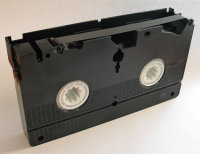The Video Home System, first released in September 1976, better known by its abbreviation VHS, is a recording and playing standard for video cassette recorders (VCRs), developed by JVC (with some of its critical technology under lucrative licensing agreements with Sony) and launched in 1976. VHS officially stands for Video Home System, but it initially stood for Vertical Helical Scan, after the relative head/tape scan technique. Some early reports claim the name originally stood for Victor Helical Scan System.
VHS became a standard format for consumer recording and viewing in the 1980s and 1990s after competing in a fierce format war with Sony's Betamax and, to a lesser extent, Philips' Video 2000. VHS initially offered a longer playing time than the Betamax system, and it also had the advantage of a far less complex tape transport mechanism. Early VHS machines could rewind and fast forward the tape considerably faster than a Betamax VCR since they unthreaded the tape from the playback heads before commencing any high-speed winding. Most newer VHS machines do not perform this unthreading step, as due to improved engineering, head-tape contact is no longer an impediment to fast winding.
Technical details
A VHS cassette contains a ½ inch (12.7 mm) wide magnetic tape wound between two spools, allowing it to be slowly passed over the various playback and recording heads of the video cassette recorder. The tape speed is 3.335 cm/s for NTSC, 2.339 cm/s for PAL. A cassette holds a maximum of about 430 m of tape at the lowest acceptable tape thickness, giving a maximum playing time of about 3.5 hours for NTSC and 5 hours for PAL at "standard" (SP) quality. Most cassettes have lower recording times because they use thicker tape, which helps avoid jams; careful users generally avoid the thinnest tapes. More recent machines usually allow the selection of longer recording times by lowering the tape speed: LP mode (for PAL and some NTSC) halves the tape speed and doubles the recording time, while EP mode (for NTSC, aka SLP mode) drops the tape speed to one-third, for triple the recording time. Of course, these speed reductions cause corresponding reductions in video quality; also, tapes recorded at the lower speed often exhibit poor playback performance on recorders other than the one they were produced on. Because of this, commercial prerecorded tapes were almost always recorded in SP mode. An unofficial LP mode with half the standard speed exists on some NTSC machines, but is not part of the VHS standard.
VHS tapes have approximately 3 MHz of video bandwidth, and a horizontal resolution of about 240 discernible lines per scanline . The frequency modulation of the luminance signal makes higher resolutions impossible within the VHS standard, no matter how advanced the recorder's technology. The vertical resolution of VHS (and all other analog recording methods) is determined by the TV standard — a maximum of 486 lines are visible in NTSC and a maximum of 576 lines in PAL.
Read more at Wikipedia.org



